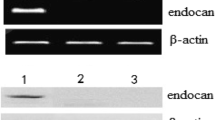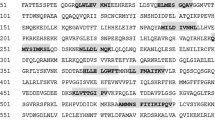Abstract
A new technology has been established to screen CTL epitope by using molecular simulation and molecular dynamics. By using this technology, four peptides of MAGE-2 were screened and further identified by peptide binding assay and cytotoxic assay. Results showed that three candidate peptides had higher affinity to HLA-A2 molecule and were able to pulse CTL activitiesin vitro in human PBMC. The results indicated that identification of CTL epitopes with computer assistant could overcome the complicated experimental steps, particularly the peptide elution step, and could directly observe peptide-MHC-I compound binding pattern and could be used to screen CTL epitopes quickly.
Similar content being viewed by others
References
van Elsas, A., van der Burg, S. H., van der Minne, C. E. et al., Peptide-pulsed dendritic cells induce tumoricidal cytotoxic T lymphocytes from healthy donors against stably HLA-A* 0201-binding peptides from the Melan-A/MART-1 self antigen, Eur. J. Immunol., 1996, 26(8): 1683–1689.
Bristol, J. A., Schlom, J., Abrams, S. I., Development of a murine mutant Ras CD8+ CTL peptide epitope variant that possesses enhanced MHC class I binding and immunogenic properties, J. Immunol., 1998, 160(5): 2433–2441.
Manici, S., Sturniolo, T., Imro, M. A. et al., Melanoma cells present a MAGE-3 epitope to CD4(+) cytotoxic T cells in association with histocompatibility leukocyte antigen DR11, J. Exp. Med., 1999, 189(5): 871–876.
Falk, K., Rotzschke, O., Stefanivic, S. et al., Allete-specific motifs revealed by squencing of self-peptides eluted from MHC molecules, Nature, 1991, 351: 290–296.
Adams, H. P., Koziol, J. A., Prediction of binding to MHC class I molecules, J. Immunol. Methods, 1995, 185(2): 181–190.
Sun, M., Che, Y., Miao, F. M. et al., Conformational analysis on anti-HIV-1 peptide T22([Tyr5,12,Lys7]-polyphemusinII), Chinese Science Bulletin, 2001, 46(20): 1685–1688.
De Backer, O., Verheyden, A. M., Boon, T., Structure, chromosomal location, and expression pattern of three mouse genes homologous to the human MAGE genes, Genomics, 1995, 28(1): 74–83.
Weynants, P., Lethe, B., Brasseur, F. et al., Expression of mage genes by non-small-cell lung carcinomas, Int. J. Cancer, 1994, 56(6): 826–829.
Tahara, K., Mori, M., Sadanaga, N. et al., Expression of the MAGE gene family in human hepatocellular carcinoma, Cancer, 1999, 85(6): 1234–1240.
Scarcella, D. L., Chow, C. W., Gonzales, M. F. et al., Expression of MAGE and GAGE in high-grade brain tumors: a potential target for specific immunotherapy and diagnostic markers, Clin-Cancer-Res., 1999, 5(2): 335–339.
Dalerba, P., Frascella, E., Macino, B. T. et al., MAGE, BAGE and GAGE gene expression in human rhabdomyosarcomas, Int-J-Cancer, 2001, 93(1): 85–90.
Visseren, M. J., van der Burg, S. H., van der Voort, E. I. et al., Identification of HLA-A*0201-restricted CTL epitopes encoded by the tumor-specific MAGE-2 gene product, Int. J. Cancer, 1997, 73(1): 125–130.
Geng, M., Jia, Z. C., Wan, Y. et al., Prediction of HLA-A2 restricted CTL epitope of tumor antigen MAGE-2, Acta Academiae Medicinae Militaris Tertiae (in Chinese), 2000, 22(10): 934–937.
Nijman, H. W., Houbiers, J. G., Vierboom, M. P. et al., Identification of peptide sequences that potentially trigger HLA-A2.1-restricted cytotoxic T lymphocytes [J], Eur. J. Immunol., 1993, 23(6): 1215–1219.
Yoon, H., Chung, M. K., Min, S. S. et al., Synthetic peptides of human papillomavirus type 18 E6 harboring HLA-A2 motif can induce peptide-specific cytotoxic T-cell from peripheral blood mononuclear cell, Virus Research, 1998, 54: 23–29.
Matsumura, M., Fremont, D. H., Peterson, P. A. et al., Emerging principles for the recognition of peptide antigens by MHC class I molecules. Science, 1992, 257(5072): 927–935.
Lim, J. S., Kim, S., Lee, H. G. et al., Selection of peptides that bind to the HLA-A2 molecule by molecular modeling. Molecular Immunlogy, 1996, 33(2): 221–230.
McCammon, J. A., Harvey, S. C., Dynamics of protein and nucleic acid, London: Cambridge University Press, 1987, 150–270.
Author information
Authors and Affiliations
Corresponding author
About this article
Cite this article
Geng, M., Wu, Y., Lin, Z. et al. Screening of HLA-A2 restricted CTL epitopes using molecular simulation. Chin. Sci. Bull. 48, 1962–1966 (2003). https://doi.org/10.1007/BF03183987
Received:
Accepted:
Issue Date:
DOI: https://doi.org/10.1007/BF03183987




